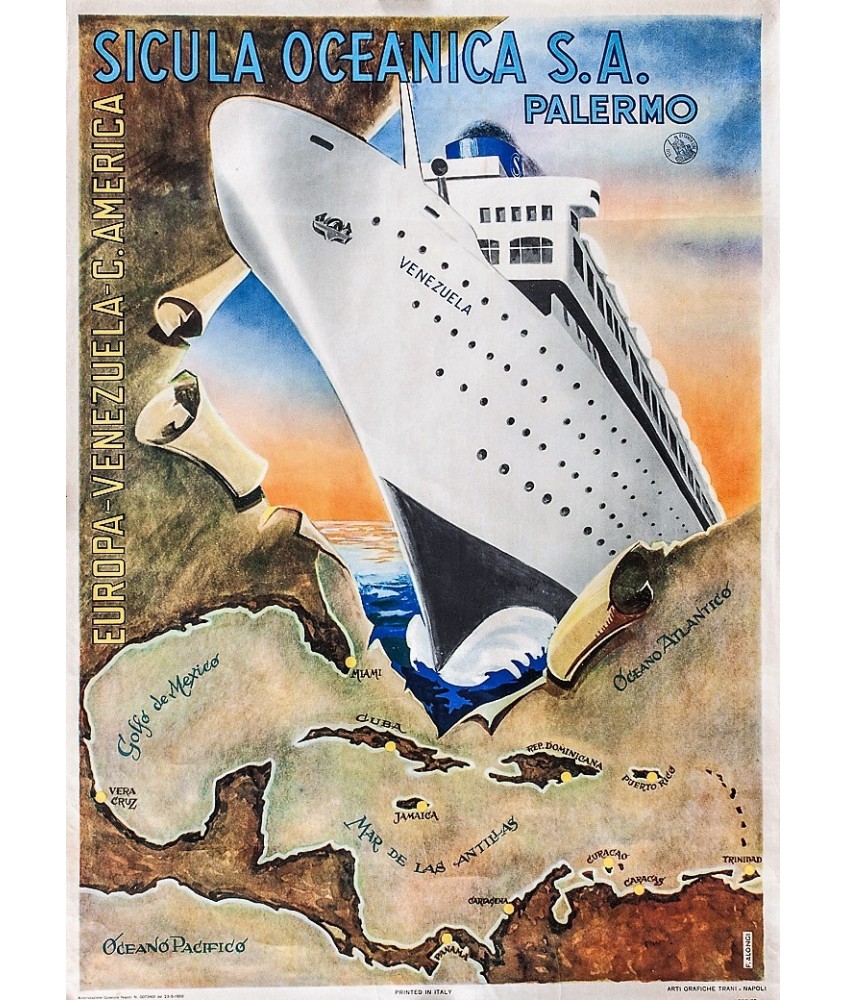


The New Zealand steamer Ruahine was purchased in January 1949 and after a refit placed in service between Italy and Central America as AURIGA. The AURIGA wasfollowed by the CENTAURO (ex- City of Hong Kong) and LUCANIA
Sicula Oceanica S.p.A. / Grimaldi SIOSA Line
The Grimaldi brothers (Fratelli Grimaldi) were nephews of Achille Lauro, the famous Naples shipowner (their mother was Achille's sister). They built up a fleet of cargo ships before World War II. Like Achille Lauro himself, they decided there was a post-war market for cheap emigrant and refugee ships, and acquired a number of elderly vessels, which received little upgrading. The New Zealand steamer Ruahine was purchased in January 1949 and after a refit placed in service between Italy and Central America as AURIGA. The AURIGA was followed by the CENTAURO (ex- City of Hong Kong) and LUCANIA (ex- Prince Robert).
The emigrant market eventually became more discerning as competition increased, and the first comfortable Grimaldi ships were the ASCANIA and IRPINIA (ex- SGTM ships Florida and Campana), acquired in 1955. Initial services were from Italy to Central America, but North Atlantic services were also operated later.
In 1956 they acquired the VENEZUELA, which had previously been the Compagnie Générale Transatlantique De Grasse, and later the Canadian Pacific Empress of Australia. Following rebuilding for their Italy-West Indies-Venezuela service, her passenger capacity increased from 664 to nearly 1500 passengers. The VENEZUELA was lost in 1962, off Cannes. She was replaced in 1965 by the CARIBIA, originally the Cosulich, later Italia Line Vulcania. She hit a rock in 1972, again off Cannes and was damaged and laid up at La Spezia.
Subsequently, Grimaldi operated the AUSONIA on cruises from 1983-96, and carried up to 55 passengers on various freighters around the world.
One of the brothers then started Grandi Navi Veloci, which operate large cruise ferries in the Mediterranean.
CLASIFICACIÓN DE LOS CARTELES SEGÚN SU CONSERVACIÓN (en negrita la correspondiente a este ejemplar):
|
|
A+ |
|
Perfecto estado de conservación, muy raro encontrar un ejemplar en este estado impecable. |
|
|
A |
|
Cartel en muy buen estado de conservación. Puede presentar algún desgarro inapreciable en los márgenes, no presenta ninguna falta de papel. Los colores son frescos y no se aprecian manchas. |
|
|
A- |
|
Puede presentar alguna leve marca de doblez, desgarro o pequeña falta de papel en los márgenes. Si presenta restauración, está realizada con éxito. |
|
|
B+ |
|
El cartel puede estar restaurado. Se aprecian levemente los defectos. |
|
|
B |
|
Cartel en buen estado de conservación. Presenta desgarros, algunas manchas y algunas faltas de papel, jamás afectando al área crucial del diseño. Los colores son frescos y el cartel tiene una apariencia general muy buena. |
|
|
B- |
|
El cartel está restaurado, se aprecian algunos defectos y leve pérdida de color en las marcas de doblez. |
|
|
C+ |
|
Las restauraciones son visibles. |
|
|
C |
|
Cartel en regular estado de conservación. Presenta desgarros, manchas, marcas de doblez y o faltas de papel que puede afectar parcialmente al área crucial del diseño, los colores pueden estar algo desvaídos y el cartel tiene una apariencia general de regular a buena. |
|
|
C- |
|
Requiere restauración. |